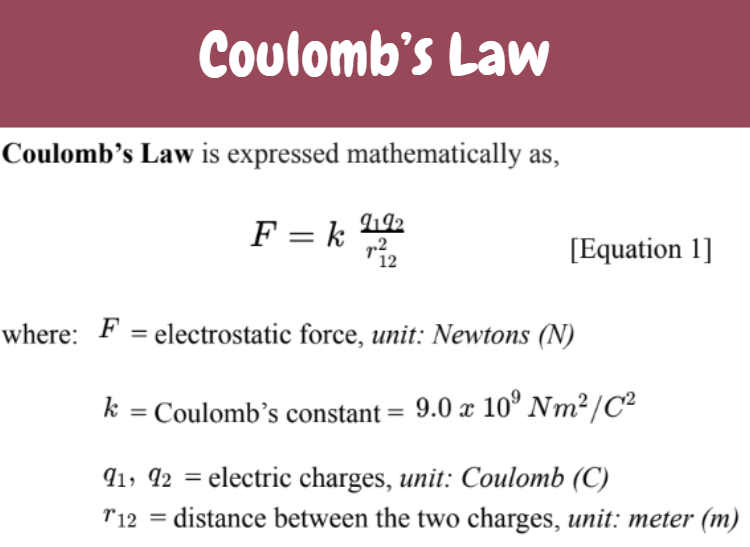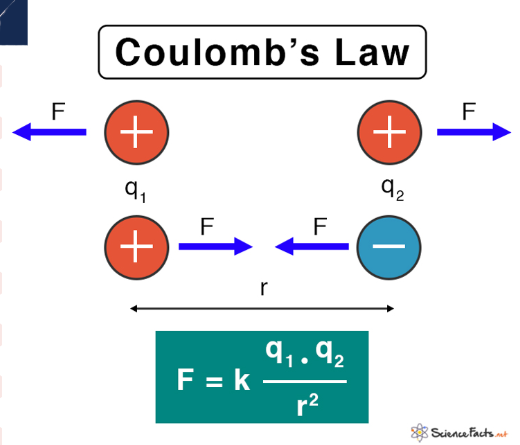Electrostatics
1/52
There's no tags or description
Looks like no tags are added yet.
Name | Mastery | Learn | Test | Matching | Spaced |
|---|
No study sessions yet.
53 Terms
It is a branch of Physics that studies slow-moving or stationary electric charges.
Electrostatics
It is the study of electromagnetic phenomena that occur when there are no moving charges.
Electrostatics
This is the law that states that like charges repel and opposite charges attract.
Law of Electrostatics
Why do like charges repel and opposite charges attract?
This is due to the nature of the electric force, which is a force that is exerted between two particles that have either opposite charges or similar charges.
What are the two types of electrical charges as suggested by Benjamin Franklin?
Positive and Negative
This type of electrical charge is associated with protons.
Positive
This type of electrical charge is basically any particle that contains less electrons than protons.
Positive
This type of electrical charge is associated with electrons.
Negative
This type of electrical charge contains more electrons than protons.
Negative
If an atom contains an equal number of protons and electrons, it is?
Electrically Neutral
If the atom contains an unequal number of protons and electrons, it is?
Electrically Charged
What is the SI Unit for the Electric Charge?
Coulomb (C)
Why is the SI Unit for the Electric Charge called a Coulomb (C)?
It was named that way in honor of French physicist Charles de Coulomb.
A Charge is _______ when the total charge in an object is the algebraic sum of all individual charges (electrons and protons) carried by the object.
Conserved
In any _____ ______, the algebraic sum of all electric charges remain the same.
close system
A Charge is _______ when the magnitude of the charge of any body is always an integral multiple of the elementary charge e.
Quantized
Electric charge cannot be divided into amounts smaller than?
The charge of one electron or proton
The charge of any macroscopic body is always either?
Zero (neutral) or an integral multiple of e
What is the formula for the total charge of electrons present in an atom?
Q = ± Ne
In the total charge of electrons formula, “Q” stands for?
electric charge of a body
In the total charge of electrons formula, “N” stands for?
Number of either proton or electron
In the total charge of electrons formula, “e” is equal to?
1.6 × 10-19 C
Objects that allow electrons to freely move across the entire material.
Conductors
Most ____ are good conductors.
metals
Materials that impede the free flow of electrons.
Insulators
The particles of an _______ do not allow the free flow of electrons and charge is seldom distributed evenly across the entire material.
insulator
Most _______ are good insulators.
nonmetals
Materials that are intermediate in their properties between good conductors and insulators.
Semiconductors
What are the three most conductive elements?
Silver
Copper
Gold
Give an example of an insulator.
Rubber
Give an example of a semiconductor.
Silicon
It is a process in which two objects become electrically charged when rubbed together.
Charging by Friction aka Triboelectric Charging
When two materials are rubbed together, electrons are transferred from one material to the other.
Electron Transfer
One material loses electrons and becomes positively charged, while the other material gains those electrons and becomes negatively charged.
Charging Effect
A process where a charged object directly touches a neutral object, allowing electrons to transfer between them.
Charging by Conduction aka Charging by Contact
Charging by _______ results in the neutral object gaining the same type of charge as the charged object.
Conduction or Contact
How does Charging by Conduction work?
A charged object (either positive or negative) comes into direct contact with a
neutral object.
Electrons transfer between the two object.
After contact, both objects have the same type of charge.
This is a method of charging a neutral object without direct contact with a charged object.
Charging by Induction
Instead of transferring electrons directly, the presence of a charged object polarizes the charges in the neutral object, and grounding is often used to complete the process. This is a method of charging is?
Charging by Induction
How does Charging by Induction work?
Bring a charged object close to a neutral object.
This causes the charges in the neutral object to rearrange (polarization).
Ground the neutral object (if needed).
If you touch the neutral object, electrons will either enter or leave depending on the charge
nearby.
Remove the ground, then remove the charged object.
The neutral object now has a permanent charge, opposite to the charge of the original
object.
A method of neutralizing or charging an object by connecting it to a large reservoir of charge, like the Earth. The ground can supply or absorb electrons as needed.
Grounding
How does Charging by Grounding work?
A charged object is brought near a neutral object.
This causes the neutral object's charges to rearrange (polarization).
The neutral object is connected to the ground.
If the object is negatively charged, excess electrons flow to the ground.
If the object is positively charged, electrons from the ground flow into it.
The ground connection is removed first, then the charged object.
The object now has a charge opposite to the original charged object.
This law states that the force between two charged objects is proportional to the product of their charges and inversely proportional to the square of the distance between them.
Coulomb’s Law
What is the formula of Coulomb’s Law?
F = k × ( (q1×q2) / (r2) )

In the formula of Coulomb’s Law, “F” stands for?
Force

In the formula of Coulomb’s Law, “q1” and “q2” stand for?
Charges 1 and 2
In the formula of Coulomb’s Law, “r” stands for?
is the distance between the charges
In the formula of Coulomb’s Law, “k” stand for?
The Coulomb Constant
(k = 9.0 × 109 Nm2/C2)
State two important relations of Electrostatic force.
Directly proportional to the product of the charges; and
Inversely proportional to the square of the distance between them.
An _______ _________ _____ occurs when two particles with opposite charges pull towards each other.
Attractive Electrostatic Force
_______ _________ _____ happens when two particles with the same charge push away from each other.
Repulsive Electrostatic Force
It's the attractive or repulsive force between two electrically charged objects.
Electrostatic Force
It is analogous to the famous Law of Gravitation formulated by Isaac Newton.
Law of Electrostatics